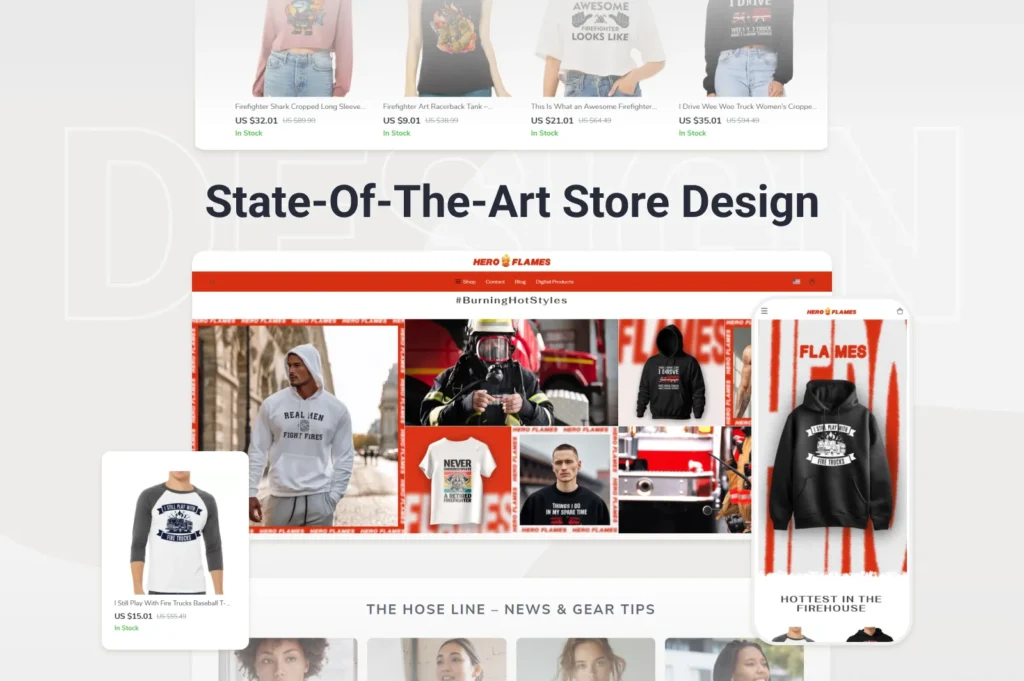When you buy an online store, your reputation becomes one of your biggest assets. It’s what makes people trust your products and your brand. In the digital world, customers can’t touch or test what they’re buying. They rely on signals: reviews, comments, mentions, and how your brand responds to them.
Your reputation shapes everything about how customers see you. Here’s the difference it can make:
| With a good reputation | With a bad reputation |
| Customers trust your brand and feel safe buying from you. | People hesitate, double-check, or leave your site without purchasing. |
| Your store appears reliable, leading to repeat buyers and word-of-mouth referrals. | Even one negative review can overshadow all your marketing efforts. |
| You spend less on advertising — your reputation does the talking. | You must constantly offer discounts just to convince people to give you a chance. |
| Small mistakes are forgiven — customers believe you’ll make things right. | Every issue becomes a reason for complaint or refund requests. |
| You attract collaborations, partners, and loyal followers. | Other businesses avoid working with you, fearing damage to their image. |
Think of your reputation as your store’s credit score: it reflects how much people believe in your brand and how consistently you deliver on your promises.
When you get a ready-made store from Offiro, the foundation for your reputation is already there — verified listings, trusted suppliers, and clean customer histories. But from there on, it’s up to you to nurture and protect it.
In this article, we’ll explore how to do that step by step from understanding what reputation management really means, to learning how to monitor and control it effectively. We’ll walk through each stage, look at the best tools and metrics to use, and show how to work with reviews to turn feedback into growth.
Stages of Reputation Management

Reputation is about being trusted, and trust directly affects your sales. According to MOZ, even one negative Google review can reduce the chances of a purchase by 21.9%. Two or three bad reviews can lower it by around 60%, and four or more — by nearly 70%.
The truth is, most shoppers don’t spend time reading product descriptions or specs. They scroll straight to the ratings and reviews, and make their decision there. That’s why managing your reputation is just as important as running ads or optimizing your site for search — it’s a key part of your marketing strategy.
When you begin working with your store’s reputation, the first step is simple: understand what people already think about you. That’s your starting point. When you buy a store from Offiro, you get access to reviews and analytics our experts collect and verify. That means you already know where you stand and can plan your next move with clarity.
Your reputation is built across multiple channels, and each one matters:
- Your blog and social media — shape your brand’s voice and personality
- Your website — the core of your credibility
- Forum discussions — where opinions often spread the fastest
- Mass media — articles, mentions, and features can boost authority
- Search engines and AI replies — what people see when they “Google” your name or ask AI about your brand
- Review and rating sites — where customer trust is won or lost in a few sentences
Each of these channels is a piece of the puzzle. Together, they form the full picture of how your audience sees your business.
Three Key Directions of Online Reputation Management

Effective reputation management spans across all channels: social media, online media, review platforms, search engines, and even AI-generated responses. But each channel has its own logic and requires a unique approach.
That’s why reputation management is usually divided into three main directions:
- Online Reputation Management (ORM)
This covers all your general online activity aimed at creating and maintaining your brand’s image. ORM involves publishing valuable content — articles, videos, case studies — sharing company updates, and amplifying positive client reviews. It’s about building a consistent, trustworthy presence that tells your story across the internet. - Search Engine Reputation Management (SERM).
This focuses on how your company appears in search results and AI answers. Using a mix of SEO (Search Engine Optimization) and AEO (Answer Engine Optimization), SERM ensures that your site ranks high in Google and is correctly represented in AI-generated summaries. The goal is simple: when people search for your brand, they should see the most accurate and positive information first. - Hidden Marketing (HM).
This is the subtle side of reputation work. It aims to create a favorable perception of your brand through indirect channels. It includes posting genuine reviews, starting or joining positive discussions, sharing useful experiences, and answering questions without explicitly promoting your company. Hidden marketing helps shape public opinion in a natural, authentic way.
These three pillars work best together. ORM builds the foundation, SERM ensures visibility, and HM strengthens trust in everyday online interactions. But since each direction requires its own expertise, you might prefer to delegate reputation management to Offiro experts. Our specialists handle all aspects of your store’s image, ensuring it grows stronger and more visible day by day.
How to Analyze Your Reputation

Before you can improve your reputation, you need to understand it. Reputation analysis isn’t just about reading reviews or checking star ratings — it’s about understanding how your brand is perceived across different platforms and what emotions your name evokes when people see it online.
1. Start with search results
Open a private (incognito) browser window and type in your store name, your brand name, and key product names.
Ask yourself:
- What comes up first?
- Are there any negative mentions?
- Does your site appear on the first page, and does it look trustworthy?
If not — that’s where SERM comes in. You’ll need to push positive, relevant content higher in search results to shape what potential customers see first.
2. Monitor reviews and ratings
Check what customers say about your products and service on:
- Trustpilot
- Reddit or Quora discussions
- Social media comments
Patterns matter more than isolated reviews. A few negative opinions are normal, but if you notice repeating issues — late deliveries, unclear descriptions, or poor communication — these are signals to act.
3. Measure social sentiment
Look at what tone dominates your brand mentions online. Are people excited, neutral, or disappointed when they talk about you? Social listening tools ( like Brand24, Sprout Social, or Hootsuite) can help you track keywords, hashtags, and mentions in real time to get an overall sense of mood.
4. Check engagement, not just numbers
Reputation isn’t only about visibility — it’s about interaction quality. A post with 20 positive, thoughtful comments is far more valuable than one with 2,000 empty likes. When analyzing your reputation, focus on:
- the nature of comments
- the tone of discussions
- how often your audience shares your content organically.
5. Compare your image to your goals
Think about what you want people to associate your brand with — reliability, creativity, eco-consciousness, exclusivity — and see if that’s what’s actually reflected online. If there’s a gap, your content and communication need to bridge it.
6. Use Offiro’s analytics advantage
When you buy a store from Offiro, you already have a head start. Our verified analytics and expert evaluations give you a clear snapshot of your store’s performance, audience perception, and review patterns. You’ll see not only what people say, but why they say it — helping you plan reputation actions based on data, not guesswork.
Your Reputation Toolkit: A Comprehensive Playbook

A strong reputation needs a comprehensive approach. Mix these tools and tactics to match your goals and avoid one-sided fixes:
- Improve overall tonality ( the vibe around your brand).
Use hidden marketing thoughtfully on forums and Q& A sites: join relevant threads, share real experiences, and steer conversations constructively. Pair this with active feedback work — ask for reviews after delivery, follow up on neutral scores, and thank customers who leave detailed positives - Shape how search engines and AI present you (SERM & AEO).
Create simple business-card microsites (brand, founder, flagship product) and build quality backlinks from directories, partner sites, and guest posts. Where possible, remove clearly false or defamatory reviews: contact the platform owner with evidence, or use legal channels for unwarranted accusations.
Don’t overdo it: a spotless profile can look suspicious. Sometimes it’s smarter to leave a negative comment visible and reply politely with facts, empathy, and a fix. - Build visible expertise (ORM).
Publish useful articles on your blog and external platforms; create educational videos that solve real customer problems (how-tos, comparisons, care guides). Anchor each piece to a specific pain point you see in reviews or support chats. - Strengthen trust through openness and fast responses.
Set SLAs for reply speed on all channels. Use clear, human language; admit mistakes; explain what you changed to prevent repeats. Close the loop with the customer and—if appropriate—invite them to update their review.
Working on reputation without a clear plan can backfire. Stay systematic and invite feedback instead of silencing it — customers often point you to improvements or blind spots you’ve missed.
Quick checklist to keep it balanced
- Weekly: monitor mentions, triage reviews, reply to all negatives
- Bi-weekly: publish or repurpose one expert asset (post/video/guide)
- Monthly: add 2–3 quality backlinks or listings; prune/remediate false reviews
- Quarterly: review sentiment trends and refresh your playbook
Metrics That Show How Your Reputation Is Really Doing

Managing your reputation is all about tracking how people feel about your brand and how that affects your sales. Measuring the right metrics helps you see what’s working, what needs improvement, and where to focus your efforts next.
Here are the key numbers worth watching:
1. Net Promoter Score (NPS)
This metric shows how many of your customers are ready to recommend you to others. It’s usually based on a simple question:
– “How likely are you to recommend our store to a friend?”
High NPS means your customers are satisfied, loyal, and willing to advocate for you. If the score is low, it’s a sign to review your service quality or communication tone.
2. Net Sentiment Rate (NSR)
This indicator measures the overall emotional tone of mentions and reviews about your brand. It shows the ratio of positive to negative comments. You can track it manually or use tools that analyze text sentiment automatically as many social listening and review management platforms do this. A healthy NSR means that your public image feels more positive than negative, even if some criticism exists.
3. Churn Rate
Churn rate shows how many customers stop buying from you over time. High churn often points to hidden issues — weak post-sale communication, lack of repeat offers, or unaddressed complaints. A stable or declining churn rate means your reputation efforts are working: people come back, and your service meets expectations.
4. Return on Investment (ROI)
Good reputation should translate into real profit. ROI helps you see if your marketing and reputation management efforts are paying off financially. When you invest in quality service, positive content, and client communication, ROI shows how much of that investment turns into revenue growth and repeat sales.
Tools That Simplify Tracking

You don’t have to calculate all these numbers manually. There are plenty of reputation monitoring tools that collect and visualize data for you: Google Analytics, Brand24, Sprout Social, and Mention.
And if you’re running a store from Offiro, you already have one of the best tools at hand. Every verified store comes with the Offiro Dashboard — a simple analytics panel that helps you:
- monitor sales, traffic, and engagement metrics
- track reviews and overall sentiment
- and connect reputation insights directly with your store’s performance
This way, you can clearly see how your reputation affects your business results — and make informed decisions faster.
How to Stay in Control of Your Reputation

Reputation management is a constant ongoing process. The moment you stop paying attention, you lose control of the story others are telling about your brand. Staying in charge means being proactive, consistent, and responsive across every channel.
1. Set up monitoring systems
You can’t control what you don’t see.
Use monitoring tools to keep track of new mentions, reviews, and discussions about your store. Tools like Google Alerts, Brand24, and Sprout Social notify you whenever your brand is mentioned, allowing you to react early before a small issue turns into a public problem.
If your store is part of the Offiro ecosystem, you can use the Offiro Dashboard to track these insights directly alongside your sales and engagement data.
2. Respond quickly and consistently
The speed and tone of your response can completely change how people perceive your brand.
Even a critical comment can strengthen your image if you:
- reply within 24 hours
- stay polite and factual
- explain the situation and offer a real solution
People don’t expect perfection, but they do expect care. A timely, professional response shows that your business listens and values every customer.
3. Create internal guidelines
If you have a team ( or plan to expand), make sure everyone knows how to communicate on behalf of your brand. Write short internal rules for tone of voice, response time, and what information can be shared publicly. This ensures that whether it’s you, a manager, or an Offiro marketing expert replying — your communication always feels like one consistent brand voice.
4. Keep your promises
Reputation is rooted in your day-to-day operations. If your shipping times, refund policy, or product quality don’t match what you advertise, no amount of PR will help. Regularly review your workflows and keep your promises. When customers see that you deliver on your word, they trust you more than any ad could ever achieve.
5. Document everything
Keep screenshots and copies of major reviews, responses, and communications — both positive and negative. This not only helps you learn and improve, but can also serve as protection in case of unfair accusations or “black PR” campaigns.
Controlling your reputation means owning your narrative — not by deleting criticism, but by responding to it with transparency and confidence. When people see that your brand communicates clearly, admits mistakes, and makes things right, trust naturally follows.
And if you want to take a step further, Offiro experts can help you build a personalized reputation control strategy from setting up monitoring systems to managing customer communication and keeping your store’s public image strong and authentic.
How to Work with Reviews

Reviews define your reputation. They’re often the first thing potential buyers read and the last thing they check before hitting “Buy” or leave forever. How you handle reviews says more about your brand than any slogan or ad ever could.
1. Encourage reviews actively
Don’t wait for customers to speak up on their own: most people only leave reviews when something goes wrong. After a successful delivery, send a short, polite message inviting them to share their thoughts. Make it easy:
- include a direct link to your review page
- keep your message short and friendly
- thank them in advance for their time
Small prompts like these can double or even triple the number of positive reviews you receive.
2. Respond to every review — good or bad
When people see that you care enough to respond, they immediately perceive your brand as more trustworthy.
- For positive reviews, say thank you and personalize your response (“We’re so glad you liked the packaging!”)
- For neutral reviews, acknowledge their feedback and show you’re working on improvements
- For negative reviews, stay calm and polite. Apologize if needed, explain what happened, and offer a solution or compensation
The goal isn’t to “win the argument», but to show that your brand listens, understands, and values every customer.
3. Don’t fake or hide reviews
It’s tempting to flood your page with glowing feedback, but most customers can spot fake reviews from a mile away. Authenticity builds more trust than perfection ever could. Keep your feedback section honest, and when possible, verify real reviews with purchase data.
4. Turn criticism into growth
Negative reviews aren’t always bad — they’re free advice. If you notice recurring complaints, use them to improve your store. Fix the problem, then let customers know you’ve made changes. People love seeing that their feedback made a difference.
5. Showcase your best reviews
Share great reviews on your website, blog, and social media. These aren’t just compliments — they’re real-life stories that help new visitors feel confident about buying from you. Visual testimonials, screenshots, or short video snippets work especially well.
Conclusion

Your reputation isn’t just a reflection of your business — it is your business. It affects how people see you, how search engines rank you, and ultimately how confident your customers feel when choosing your products.
Building a solid reputation takes time, patience, and consistency. It’s all about earning trust through real actions: delivering quality goods, being transparent, listening to feedback, and handling criticism gracefully.
Whether you’re working on improving, maintaining, or creating your reputation from scratch, remember: every message, every review, and every customer interaction contributes to the story your brand tells.
When you buy a store through Offiro, you’re already several steps ahead: you start with a verified reputation, clean analytics, and a professional foundation built by experts. From there, you can continue to grow that reputation with confidence, knowing you have access to the tools, guidance, and support that help your business stand out for the right reasons.
Explore Offiro today and see how easily your entrepreneurial journey can begin.

















